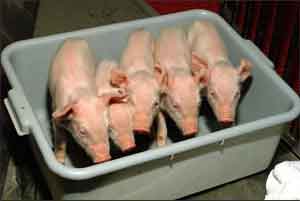- Home
- Editorial
- News
- Practice Guidelines
- Anesthesiology Guidelines
- Cancer Guidelines
- Cardiac Sciences Guidelines
- Critical Care Guidelines
- Dentistry Guidelines
- Dermatology Guidelines
- Diabetes and Endo Guidelines
- Diagnostics Guidelines
- ENT Guidelines
- Featured Practice Guidelines
- Gastroenterology Guidelines
- Geriatrics Guidelines
- Medicine Guidelines
- Nephrology Guidelines
- Neurosciences Guidelines
- Obs and Gynae Guidelines
- Ophthalmology Guidelines
- Orthopaedics Guidelines
- Paediatrics Guidelines
- Psychiatry Guidelines
- Pulmonology Guidelines
- Radiology Guidelines
- Surgery Guidelines
- Urology Guidelines
Scientists create safer pig organs with goal of transplants for humans

Scientists at a Massachusetts company seeking to make pig organs safe enough to be transplanted into humans have used gene-editing technology to clone piglets that lack a potentially dangerous retrovirus, according to a study released on Thursday.
The breakthrough, according to authors of the study published in the journal Science, could help pave the way for transplantation of whole pig organs into humans, without fear of patients being infected with the pig retrovirus. But other hurdles remain.
Transplants from pigs could offer a new potentially life-saving alternative for patients diagnosed with organ failure and no other viable treatment options. A shortage of available human organs has led scientists to study the possibility of animal donors to close the gap.
About 20 people die each day in the United States while awaiting an organ transplant, according to the United Network for Organ Sharing.
The latest experiment was conducted by scientists at the Cambridge, Massachusetts-based company eGenesis. They used a technology known as CRISPR that works as a type of molecular scissors, trimming away unwanted parts of a genome.
The scientists created pig genes that lacked the problematic retrovirus, then used a cloning technique to produce pig embryos, according to a statement from eGenesis. The embryos were implanted into normal sows, and the mother pigs later gave birth to the cloned piglets.
The clones, which were born without the retrovirus, will be monitored for long-term effects from the procedure.
"This research represents an important advance in addressing safety concerns about cross-species viral transmission," Luhan Yang, co-founder and chief scientific officer at eGenesis, said in a statement.
Pigs have long been seen as a viable source for organ transplants to humans because their organs are similar in size. Scientists have specifically studied the potential for transplanting swine hearts, kidneys, livers and lungs.
Scientists in decades past experimented with transplanting chimpanzee organs into human patients but turned their focus to pig organs instead after finding them to be more suitable donor candidates.
One key remaining obstacle is how to produce pig organs that, once transplanted, will not produce an immunological rejection in human patients an issue also under study by eGenesis scientists, the company said.
(Reporting by Alex Dobuzinskis; Editing by Steve Gorman and Sandra Maler)

Disclaimer: This site is primarily intended for healthcare professionals. Any content/information on this website does not replace the advice of medical and/or health professionals and should not be construed as medical/diagnostic advice/endorsement or prescription. Use of this site is subject to our terms of use, privacy policy, advertisement policy. © 2020 Minerva Medical Treatment Pvt Ltd